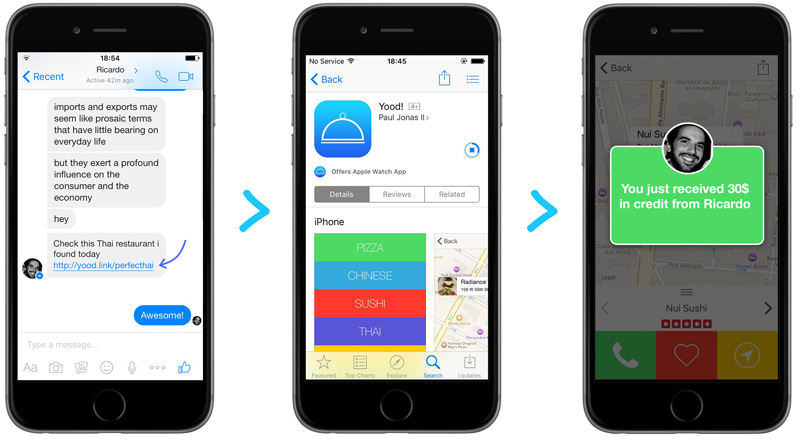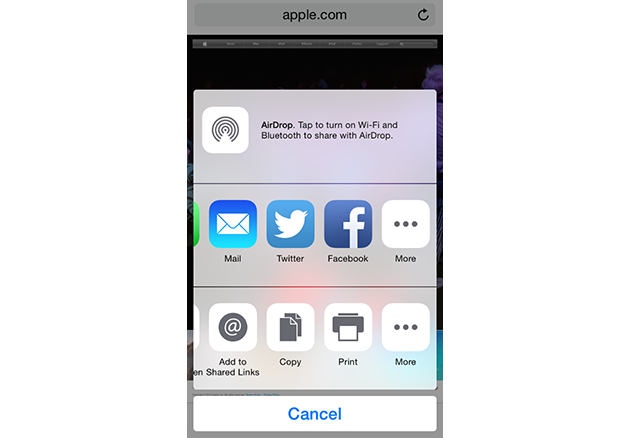Referrals
Allow your users to invite others through referrals. We will use smart links to identify the user sending the invite and once the invited user opens the app we are going to display a personalized landing page to make the experience extra special and welcome.

Take a step further and combine referrals with coupons to increase its efficiency. We are going to start by preparing your app to generate and share smart links.
Step 1: Sharing the smart link
Generate referrals with smart links through our SDK using query parameters or metadata.
It’s up to you to decide which method suits you. Moreover, you can use and combine both
if you need to.
Option 1: Smart links with query parameters
With query parameters your links will have extra information visible, e.g.
http://app.hoko.link/invitation?referrer=OfjaiSD8h9238. These links are easier to create
and to be shared because there is no need for pre-configurations.
In this example we are going to have a look on how to create a smart link with
parameters as a referral link, using the SDK and its generateSmartlinkForDeeplink method.

Then, we are going to share the message using iOS UIActivityViewController, so Ricardo can pick
the messaging app that we wants to send the message. Let’s have a look at the code
needed to generate and share the smart link:
#import <Hoko/Hoko.h>
- (IBAction)inviteButtonTapped:(id)sender {
NSString *referrerName = self.currentUser.name;
// Create the smart link based on queryParameters
HOKDeeplink *deeplink = [HOKDeeplink deeplinkWithRoute:@"invite"
routeParameters:nil
queryParameters:@{@"referrer": referrerName}
metadata:nil];
// Generate the smart link based on a deep link
[[Hoko deeplinking] generateSmartlinkForDeeplink:deeplink success:^(NSString *smartlink) {
// Initialize a new iOS share sheet with your share message
NSString *shareMessage = @"Join me, this app is a-mazing!";
// Assign the URL of the smart link
NSURL *smartURL = [NSURL URLWithString:smartlink];
UIActivityViewController *shareController = [[UIActivityViewController alloc] initWithActivityItems:@[shareMessage, smartURL]
applicationActivities:nil];
// And... it's ready! Let's present the share popup to the user
[self presentViewController:shareController animated:YES completion:nil];
} failure:^(NSError *error) {
NSLog(@"%@", error.description);
[self showErrorPopup];
}];
}@IBAction func inviteButtonTapped(sender: AnyObject) {
let referrerName = currentUser.name;
let deeplink = HOKDeeplink(route: "invite", routeParameters: nil, queryParameters: ["referrer": referrerName], metadata: nil)
// Generate the smart link based on a deep link
Hoko.deeplinking().generateSmartlinkForDeeplink(deeplink, success: { smartlink in
if let smartURL = NSURL(string: smartlink) {
// Initialize a new iOS share sheet with your share message
let shareMessage = "Join me, this app is a-mazing!"
// Assign the URL of the smart link
let shareController = UIActivityViewController(activityItems: [shareMessage, smartURL], applicationActivities: nil)
// And... it's ready! Let's present the share popup to the user
self.presentViewController(shareController, animated: true, completion: nil)
}
}) { error in
println(error.description)
self.showErrorPopup()
}
}Thanks to HOKDeeplink:queryParameters this will generate a smart link like
http://app.hoko.link/invitation?referrer=OfjaiSD8h9238. Alternatively, you could create the same
smart link using metadata.
Option 2: Smart links with metadata
Smart links with metadata requires you
to assign and load data when creating and parsing the smart link. Nevertheless, these links are
shorter and clearer because they don’t use HTTP query parameters,
e.g. http://app.hoko.link/invitation.
Metadata are ideal to hide and control sensitive data. They also have the advantage of supporting unlimited meta data, unlike query parameters where you are limit by the length of the URL.
Use the HOKDeeplink:metadata attribute to pass a dictionary with the respecting metadata
to be saved with the smart link. Read more information about
metadata.
Step 2: Personalized landing page
Now that we know how to create and share referral smart links, we must handle these links once the users opens the app. We are going to make it extra special by displaying which friend invited the user and what is the reward.

In this simple example we are going to parse the deep link generated by the smart link and present the appropriate view to the user. We are also going to pass the name of the user (in this case Ricardo) that referred the new user. You can go even further by getting the user picture and other information from your back end.
// Add this to your application:didFinishLaunchingWithOptions delegated method
[[Hoko deeplinking] mapRoute:@"invite" toTarget:^(HOKDeeplink *deeplink) {
if (deeplink.queryParameters[@"referrer"]) {
// Present your personalized landing page with the referrer name
NSString *referrerName = deeplink.queryParameters[@"referrer"];
[self showInviteSignUpViewControllerWithReferrer:referrerName];
} else {
// The deep link does not contain any information about the referrer
[self showSignUpViewController];
}
}];// Add this to your application:didFinishLaunchingWithOptions delegated method
Hoko.deeplinking().mapRoute("invite", toTarget: { deeplink in
if let referrerName = deeplink.queryParameters?["referrer"] {
// Present your personalized landing page with the referrer name
showInviteSignUpViewControllerWithReferrer(referrerName)
} else {
// The deep link does not contain any information about the referrer
showSignUpViewController()
}
})That’s it. You now have a customized referral experience that your users are going to love!
More information
Need to know more about this? You can find more information in the following pages:
Check our frequently asked questions or send us a message if you can’t find what you are looking for. We’re always glad to hear from you and answer all your questions.
